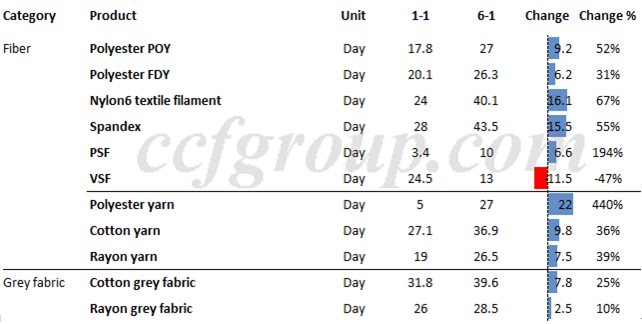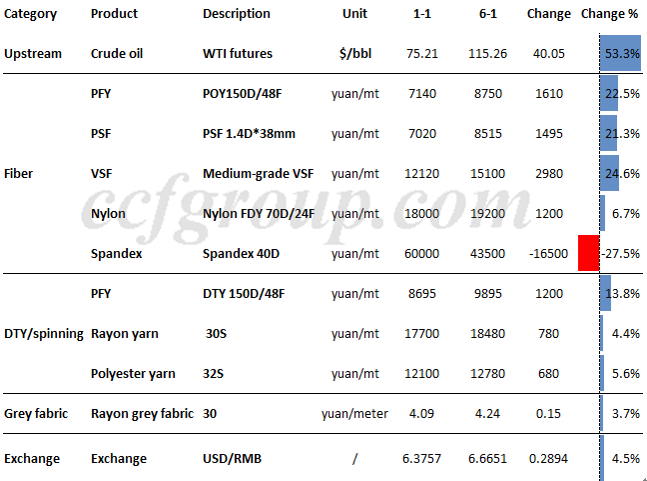Chemical fiber industry in H1 2022: Moving forward under burden
In the first half of 2022, global situation has changed dramatically, bringing great challenges to the development of real economy. In terms of external environment, the conflict between Russia and Ukraine has further intensified supply chain shortage, resulting into general price increase in global energy, agriculture and other related fields. Inflationary pressure has become an important issue for governments of various countries. As for domestic market, many links including production and circulation was disrupted by the spread of pandemic unexpectedly. Many fields like the real estate and consumption faced downward pressure, apparently impacting domestic demand. In addition, the central banks of many nations adjusted monetary policies, ending up with greatly volatile exchange rate and more complicated performance. In this context, chemical fiber industry encountered prominent pressure this year. Enterprises were confront with high cost, muted demand, high inventory, meager efficiency and other issues.
I. Chemical fiber industry: high operating rate in the first quarter and rapid decline in the second quarter
In the first quarter of 2022, the operating rate of chemical fiber industry was high and the production showed strong upward momentum. The production curtailment during the Spring Festival holiday was weaker than the same period of past years as many had turnaround or cut production in Q4 2021. The operating rate of chemical fiber industry was high in Jan-Feb, 2022, and rose to high level in Mar after plants successively resumed operation after the Spring Festival holiday.
However, since the second half of Mar, the logistics were slow when the spread of pandemic worsened in some regions of China and lockdown started. Downstream wholesale and retail sales were under pressure. With stifled logistics, the operating rate of downstream plants gradually descended.
In Apr, the impact of the epidemic situation further expanded, resulting into a sharp decline in the operating rate of the industry. From the upstream chemical fiber spinning factory to the downstream DTY plants, fabric mills and even printing and dyeing factories, there was a significant production reduction. Factories in some regions even all suspended production for a short period amid the pandemic lockdown.
In May, with gradual alleviation of epidemic, delivery of enterprises accelerated and trading atmosphere slightly warmed up. However, compared with the corresponding period of past years, orders could only be described as rise modestly. Factories dare not ramp up run rate with big pressure from capital, sales and inventory.
According to the current situation estimates, the production of chemical fiber industry may see negative growth in the first half of 2022.
II. Chemical fiber enterprises face high cost, muted demand, high inventory and poor profit
High cost
Since the second half of 2020, with easing epidemic worldwide, the crude oil price stopped falling and recovered, and returned to the pre-epidemic level in the first half of last year (WTI futures around US$60/barrel). However, the energy crisis thereafter has shown signs of further aggravation, especially due to the outbreak of the conflict between Russia and Ukraine in Mar, 2022, which led to tighter supply of crude oil. The oil price rose sharply by more than US$100/barrel, and even hit US$ 130/barrel at the highest, which basically doubled compared with that before the epidemic, bringing huge cost pressure to the whole chemical fiber industry.
Muted demand
With soaring cost, demand has weakened significantly. At the beginning of the year, enterprises witnessed insufficient orders. After the outbreak of the epidemic in Mar and Apr, sales of terminal products such as textile and apparel were shut down periodically and domestic demand was insufficient. Factors such as epidemic control also hindered export delivery, which further affected export orders. In addition, the pressure of the real estate market this year also brought negative impact to the chemical fiber industry.
High inventory
Since the beginning of the year, most chemical fiber enterprises were under high inventory burden. According to the statistics of CCFGroup, the inventory days of large-scale enterprises increased significantly in early Jun compared with the beginning of 2022, and the median of inventory days increase in the industry reached more than one week.
On the one hand, the inventory pressure reflected the poor sales and slack demand of the enterprise, on the other hand, it also meant that the capital turnover of the factories was under pressure. Some factories might face pressure to undersell in some periods. Some factories have risks of losses.

Poor profit
The price of raw materials has risen sharply, while the demand was insufficient and the product inventory was high, which resulted into the lack of bargaining power of the factories and the inability to pass on the cost through price increase. Therefore, the benefit of the chemical fiber factories was obviously compressed, and the enterprises saw apparently bigger operation pressure than past years.
According to the statistics from CCFGroup, WTI crude oil futures price increased by more than 50% in early-Jun compared with the beginning of 2022, while the increment of PFY and PSF was only around 20%, and that of NFY was below 10%. In fact, prices of downstream products increased less. Many spinners, DTY plants and fabric mills saw great losses.

III. RMB exchange rate issue
This year's exchange rate trend is still worthy of attention. In May, driven by the expectation of the Federal Reserve to raise interest rates, the US dollar index continued to rise, leading to a significant depreciation of the RMB against the dollar, which had a certain impact on the market mentality. Recently, the depreciation of RMB has eased moderately, but from the follow-up expectation, the depreciation may not be over yet, still need to make psychological preparation.
The impact of the devaluation of the RMB is two-way:
For the varieties with large proportion of raw material import, the rapid depreciation of RMB led to a sharp rise in cost, and the pressure of enterprises increased accordingly. For example, the import of pulp, raw material of viscose, and PX, upstream product of polyester fiber, have seen surging cost due to the depreciation of RMB.
For export-oriented products, RMB depreciation will bring a certain price advantage, but it is worth noting that RMB is only depreciated against the US dollar, while compared with Southeast Asian countries, the competitive advantage is not obvious. In addition, great fluctuation of short-term exchange rate will also render enterprise to show watch-and-see stance in placing orders to a certain extent.
IV. The main problems facing enterprises
In 2022, the enterprises are faced with multiple factors such as high raw material cost, the impact of pandemic on operating rate, stunted demand amid downward economy, the fluctuation of RMB exchange rate and so on, which ended up with apparently big operation pressure. Among them, the main problem is the lack of orders.
The problem of orders is closely related to economic demand, as well as related factors such as logistics and epidemic prevention and control. For example, the Keqiao Textiles and Fabrics Exhibition, held on May 23, was postponed due to an outbreak of the epidemic, and the risk of similar disturbances may be minimized later. The recent national bottom-up policy is expected to guide demand repair, but it may still take some time.
The other is the capital problem. Against the background of global inflation this year, the pressure of high raw material costs is difficult to change significantly in the short term, while higher costs mean more capital occupation; Due to the stagnant sales, the backlog of product inventory and the extension of time, the financial pressure of the enterprise is also increasing, and the purchase of raw materials and daily operation are also relatively limited, which leads to operation difficulty in enterprise and even the possibility of shutdown in some time.
- Top keywords
- Cotton Price
- Cotton Futures Price
- Cotton Futures
- CZCE
- PTA Futures Price
- Chemical Fiber
- Polyester Prices
- Wool price
- PTA Futures
- Shengze Silk
- China
- Yarn Price
- price
- China Textile City
- Fibre Price
- Benzene Price
- Cotton
- Index
- Cotton Index
- PTA
- fabric price
- NYMEX
- Top 10
- textile industry
- Spot Cotton
- Cotton Yarn
- Polyester Price
- Futures
- PTA Price
- cotton yarn price

